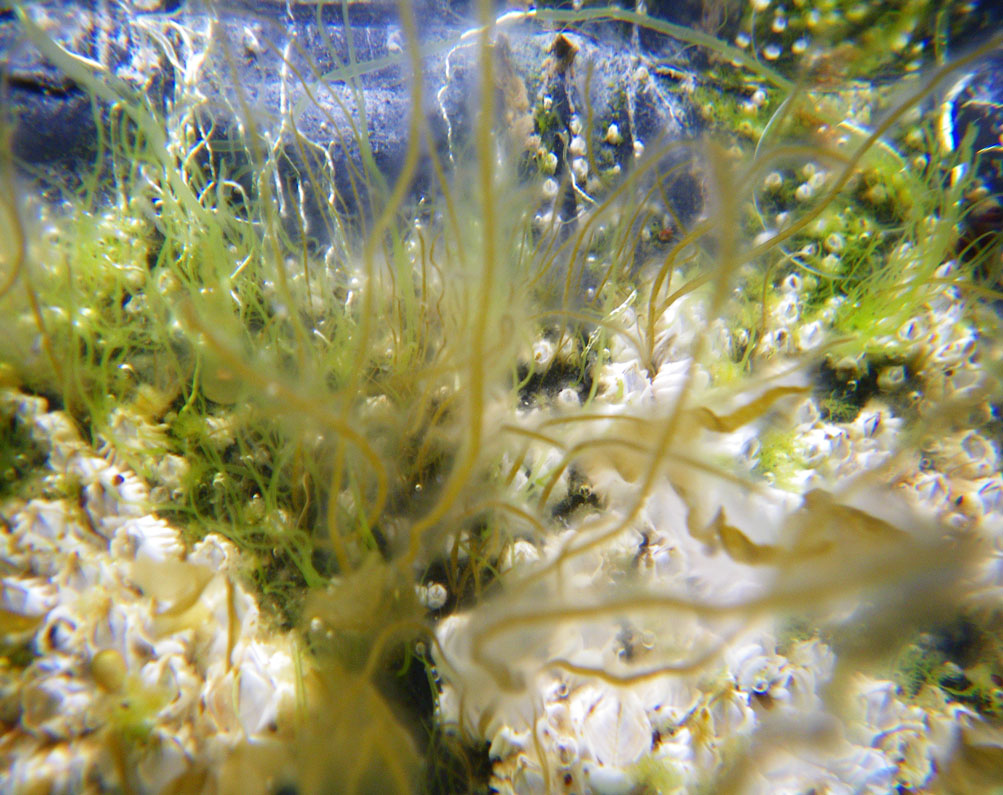Hairy brown seaweed • Haplogloia andersonii
Identification
This brown seaweed has a soft, slimy texture and hairy appearance caused by hair-like filaments attached to the thallus, which is highly- and irregularly-branched. It grows to 50 cm long.
Habitat & Range
Hairy brown seaweed grows on rock in the mid- to low intertidal and in tidepools. It is a spring annual, and is found on moderately protected shorelines from Kodiak Island, Alaska to Baja California, Mexico.
Similar Species
Haplogloia kuckuckii has been recorded on the BC coast, and is distinguished from H. andersonii by the presence of hair-like filaments on only the ends of the branches. While it is currently listed as a distinct species, H. kuckuckii and H. andersonii may actually be the same species.
This brown seaweed has a soft, slimy texture and hairy appearance caused by hair-like filaments attached to the thallus, which is highly- and irregularly-branched. It grows to 50 cm long.
Habitat & Range
Hairy brown seaweed grows on rock in the mid- to low intertidal and in tidepools. It is a spring annual, and is found on moderately protected shorelines from Kodiak Island, Alaska to Baja California, Mexico.
Similar Species
Haplogloia kuckuckii has been recorded on the BC coast, and is distinguished from H. andersonii by the presence of hair-like filaments on only the ends of the branches. While it is currently listed as a distinct species, H. kuckuckii and H. andersonii may actually be the same species.
References
Gabrielson, Paul W., Thomas Benjamin Widdowson, and Sandra C. Lindstrom. Keys to the seaweeds and seagrasses of southeast Alaska, British Columbia, Washington, and Oregon. No. 8. University of British Columbia, 2012.
Guiry, M.D. & Guiry, G.M. (2016). Haplogloia andersonii (Farlow) Levring. AlgaeBase. National University of Ireland, Galway. Accessed 09/06/2016.
Lamb, A., and Hanby, B. (2005). Marine Life of the Pacific Northwest [electronic version]. Madeira Park, BC: Harbour Publishing.
Lindberg, M. and Lindstrom, S. (2010). Haplogloia andersonii Hairy Brown Seaweed. Seaweeds of Alaska. Accessed 09/06/2016.
Authors and editors of page
Kelly Fretwell (2016).
Gabrielson, Paul W., Thomas Benjamin Widdowson, and Sandra C. Lindstrom. Keys to the seaweeds and seagrasses of southeast Alaska, British Columbia, Washington, and Oregon. No. 8. University of British Columbia, 2012.
Guiry, M.D. & Guiry, G.M. (2016). Haplogloia andersonii (Farlow) Levring. AlgaeBase. National University of Ireland, Galway. Accessed 09/06/2016.
Lamb, A., and Hanby, B. (2005). Marine Life of the Pacific Northwest [electronic version]. Madeira Park, BC: Harbour Publishing.
Lindberg, M. and Lindstrom, S. (2010). Haplogloia andersonii Hairy Brown Seaweed. Seaweeds of Alaska. Accessed 09/06/2016.
Authors and editors of page
Kelly Fretwell (2016).




